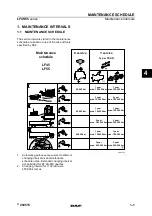
ENGINE ELECTRICAL 6Y-22
C A U T IO N : When adjusting belt ten
sion, apply p ressu re at center of gener
ator, never against either end frame.
GENERATING SYSTEM
TROUBLE SYMPTOMS
Abnormal operation of the generating system
is usually indicated by one or more of the follow
ing symptoms:
1. Battery undercharged (low specific gravity
of electrolyte).
2. Battery using an excessive amount of water,
indicating an extremely high charging rate.
3. Excessive generator noise or vibration.
4. Failure of indicator lamp to illuminate
when ignition or control switch is turned on (engine
not running).
5. Indicator lamp continues to glow with en
gine running.
6. Indicator lamp fails to go out when ignition
or control switch is turned off.
1.
Ammeter shows a high charging rate with
a fully charged battery.
8.
Ammeter shows a low or no-charge with a
partially discharged battery.
GENERATOR ON-VEHICLE TEST
The following is a list of the most common
generator defects encountered:
1. Open or shorted generator diodes.
2. Open, shorted, or grounded stator winding.
3. Open, shorted, or grounded field winding.
4. Worn generator brushes.
5. Excessive generator noise.
Generator diodes and stator windings should
be checked as explained under "Generator Output
Test" later in this section. If a defect is indicated
by this test, remove the generator and repair.
Generator field windings and brushes should
be checked as outlined under "Charging System
Trouble Analysis Chart" later in this section. If
this check indicates a defect in the field winding,
remove the generator and repair. Replace worn
brushes as explained under "Generator Brush R e
placement" later in this section.
Excessive generator noise is usually the re
sult of one or more of the following:
1.
Brush "Squeal" caused by a hard spot on
one of the brushes or rough or dirty slip rings.
To check for brush "Squeal," remove gener
ator drive belt and spin generator drive pulley by
hand. Lift brushes off slip rings and spin drive
Figure
3
— Jumper Lead Connections for Testing
Indicator Lamp Circuit (Typical)
pulley again. If noise disappears, clean andinspect
slip rings and replace brushes if worn.
2. Dry or rough bearings in generator end
frame.
I M P O R T A N T : Dry or rough bearings may be
the result of over-tightening generator drive belt(s).
loose generator mountings, or an unbalanced gen
erator fan or pulley. Remove generator and repair.
3. A defective diode or stator resulting in an
electrical unbalance.
To check for a defective diode or stator, per
form "Generator Output Test” explained later in
this section. If a defect is indicated by this test,
remove generator and repair.
GENERATOR CHARGE INDICATOR
LAMP CIRCUIT TEST
N O T E : Refer to procedure outlined in "Charg
ing System Trouble Analysis Chart" later in this
section to determine whether something other than
a generator or regulator defect is indicated before
proceeding with this test which applies to vehicles
equipped with a charge indicator lamp.
1. Check the indicator lamp bulb which may be
burned out. Make sure socket is fully engaged.
2. Check wiring connections at junction.
3. Lift the regulator terminal latch slightly,
then pull connector from regulator terminals.
C A U T IO N : Do not allow any leads to
contact a ground or "liv e " wire or te rm
inal except a s directed. A heavy cloth,
taped in position below regulator te rm
inals, will a s s is t in preventing contact.
CHEVROLET SERIES 70 -80 H EAVY DUTY TRUCK SH O P M A N U A L
Summary of Contents for 70 1969 Series
Page 1: ...CHEVROLET HEAVY DUTY TRUCK SHOP MANUAL...
Page 3: ......
Page 11: ...LUBRICATION 0 4 CHEVROLET SERIES 70 80 HEAVY DUTY TRUCK SHOP MANUAL...
Page 27: ......
Page 119: ......
Page 361: ......
Page 371: ......
Page 427: ......
Page 443: ......
Page 451: ......
Page 493: ......
Page 499: ......
Page 549: ......
Page 555: ......
Page 609: ......
Page 715: ...am...
Page 745: ......
Page 910: ......
Page 913: ......




































